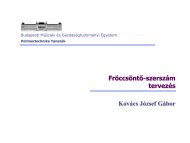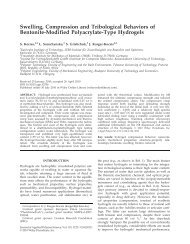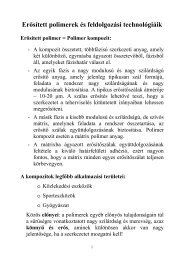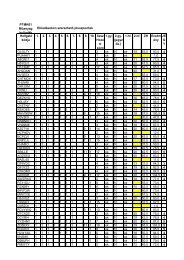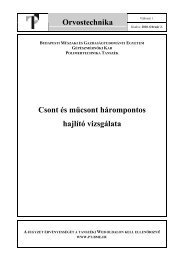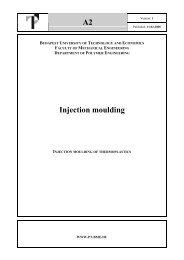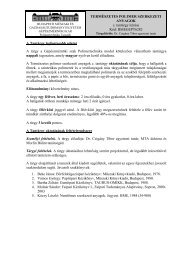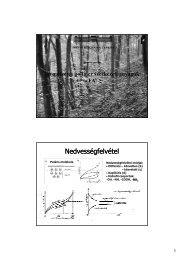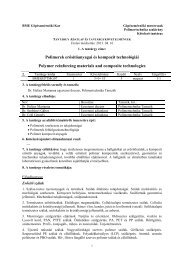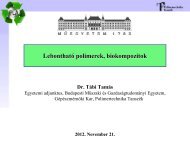Injection moulded all-polypropylene composites composed of ...
Injection moulded all-polypropylene composites composed of ...
Injection moulded all-polypropylene composites composed of ...
Create successful ePaper yourself
Turn your PDF publications into a flip-book with our unique Google optimized e-Paper software.
Composites Science and Technology 73 (2012) 72–80<br />
Contents lists available at SciVerse ScienceDirect<br />
Composites Science and Technology<br />
journal homepage: www.elsevier.com/locate/compscitech<br />
<strong>Injection</strong> <strong>moulded</strong> <strong>all</strong>-<strong>polypropylene</strong> <strong>composites</strong> <strong>composed</strong> <strong>of</strong> <strong>polypropylene</strong><br />
fibre and <strong>polypropylene</strong> based thermoplastic elastomer<br />
Ákos Kmetty a,b,⇑ , Tamás Bárány b , József Karger-Kocsis a,b<br />
a MTA–BME Research Group for Composite Science and Technology, Muegyetem rkp. 3, H-1111 Budapest, Hungary<br />
b Department <strong>of</strong> Polymer Engineering, Faculty <strong>of</strong> Mechanical Engineering, Budapest University <strong>of</strong> Technology and Economics, Muegyetem rkp. 3, H-1111 Budapest, Hungary<br />
article<br />
info<br />
abstract<br />
Article history:<br />
Received 29 July 2012<br />
Received in revised form 20 September 2012<br />
Accepted 23 September 2012<br />
Available online 4 October 2012<br />
Keywords:<br />
A. Polymer-matrix <strong>composites</strong> (PMCs)<br />
B. Impact behaviour<br />
B. Mechanical properties<br />
E. <strong>Injection</strong> moulding<br />
All-<strong>polypropylene</strong> <strong>composites</strong><br />
All-<strong>polypropylene</strong> <strong>composites</strong> comprising <strong>of</strong> <strong>polypropylene</strong> based thermoplastic elastomer (TPE) matrix<br />
and <strong>polypropylene</strong> homopolymer (hPP) fibre reinforcement were prepared and processed by injection<br />
moulding. For the injection moulding <strong>of</strong> plaque specimens pre-impregnated pellets, prepared by combined<br />
filament winding and film stacking were used. The processing–structure–property relationships<br />
<strong>of</strong> the <strong>all</strong>-PP <strong>composites</strong> were studied on specimens cut from the plaques produced at different melt<br />
temperatures (120, 140, 160 °C). The properties determined covered the moulding-induced shrinkage,<br />
flexural stiffness via dynamic mechanical analysis, static tensile and high-speed perforation impact<br />
behaviours. It was demonstrated that by using TPE as matrix the processing window <strong>of</strong> this novel<br />
<strong>all</strong>-PP composite could be significantly increased. The static tests demonstrated that the yield stress<br />
and tensile modulus <strong>of</strong> the <strong>all</strong>-PP <strong>composites</strong> were prominently increased. Optical micrographs taken<br />
from polished sections <strong>of</strong> the <strong>composites</strong> confirmed good interfacial adhesion between the matrix and<br />
the fibres. It was established that the shrinkage behaviour <strong>of</strong> the TPE based <strong>all</strong>-<strong>polypropylene</strong> <strong>composites</strong><br />
is similar to that <strong>of</strong> conventional <strong>polypropylene</strong>.<br />
Ó 2012 Elsevier Ltd. All rights reserved.<br />
1. Introduction<br />
Fibre-reinforced rubber <strong>composites</strong> have widely been used. Most<br />
systems employed continuous and short fibres because <strong>of</strong> improved<br />
properties <strong>of</strong> the <strong>composites</strong>. Various studies were published on<br />
short fibre reinforced <strong>composites</strong> which include rayon, p-aramid<br />
(Kevlar), m-aramid (Nomex), polyester and glass fibres [1,2].<br />
Recently thermoplastic elastomers (TPEs) have been applied as<br />
matrix materials to produce discontinuous natural and man-made<br />
fibre-reinforced <strong>composites</strong>. TPEs can be made by copolymerization<br />
(resulting in block or graft copolymers) or by blending techniques<br />
[3,4]. In blending usu<strong>all</strong>y a thermoplastic polymer is combined with<br />
a suitable elastomer material. The thermoplastic polymer forms the<br />
continuous phase whereas the elastomer is the dispersed one.<br />
Polyolefin-based TPEs with ‘‘dispersed elastomer’’ phase can also<br />
be produced by copolymerization. Using TPE as matrix and thermoplastic<br />
fibres as reinforcement <strong>composites</strong> with a wide processing<br />
window can be produced because the melting temperature <strong>of</strong><br />
semicryst<strong>all</strong>ine TPE materials is very low (80–100 °C) compared<br />
to semicryst<strong>all</strong>ine thermoplastic fibres (130–260 °C) [5,6]. Their<br />
⇑ Corresponding author at: MTA–BME Research Group for Composite Science and<br />
Technology, Muegyetem rkp. 3, H-1111 Budapest, Hungary. Tel.: +36 1 463 1594;<br />
fax: +36 1 463 1527.<br />
E-mail address: kmetty@pt.bme.hu (Á. Kmetty).<br />
combination opens a new horizon for the industrial production <strong>of</strong><br />
<strong>all</strong>-polymer <strong>composites</strong>. Nowadays, <strong>all</strong>-polymer and self-reinforced<br />
materials/<strong>composites</strong> [7] can be produced with narrow processing<br />
window by hot compaction (single-component self-reinforced<br />
materials (SRM)) [8–11], consolidation <strong>of</strong> coextruded tapes<br />
[12–14] and film-stacking methods (multi-component SRM)<br />
[15–21]. In addition, <strong>all</strong> <strong>of</strong> the above processing methods yield<br />
sheet-like (pre)products which can be shaped thereafter by<br />
therm<strong>of</strong>orming. Three-dimensional parts with complex geometry<br />
cannot be produced and thus the most design-friendly and versatile<br />
processing, i.e. injection moulding, cannot be adapted. Therefore<br />
considerable efforts are in progress to produce injection-mouldable<br />
self-reinforced <strong>polypropylene</strong> <strong>composites</strong>.<br />
In this article we describe the preparation <strong>of</strong> injection mouldable<br />
<strong>all</strong>-<strong>polypropylene</strong> <strong>composites</strong> by using <strong>polypropylene</strong>-based<br />
thermoplastic elastomer as matrix material and high-tenacity<br />
<strong>polypropylene</strong> (PP) fibre as reinforcement, and report on their<br />
processing–structure–property relationships.<br />
2. Materials, their processing and testing<br />
2.1. Materials<br />
Highly oriented <strong>polypropylene</strong> homopolymer (hPP) multifilament<br />
(Stradom S.A., Czestochowa, Poland) was selected and used<br />
0266-3538/$ - see front matter Ó 2012 Elsevier Ltd. All rights reserved.<br />
http://dx.doi.org/10.1016/j.compscitech.2012.09.017
Á. Kmetty et al. / Composites Science and Technology 73 (2012) 72–80 73<br />
as reinforcement. This reinforcing multifilament had a melting<br />
temperature <strong>of</strong> 173 °C (determined by DSC), single fibre diameter<br />
<strong>of</strong> 40.1 ± 1.8 lm, tensile strength <strong>of</strong> 581 ± 30 MPa and tensile modulus<br />
<strong>of</strong> 6432 ± 490 MPa (measured in single fibre tensile tests).<br />
As matrix material <strong>polypropylene</strong>-based thermoplastic elastomer<br />
(TPE) (Versify 4200, Dow Chemical Company) was selected<br />
and used. According to Fourier Transform Infrared Spectroscopy<br />
(FTIR) this TPE was a propylene–ethylene copolymer. Its Melt Flow<br />
Index (MFI) was determined with a CEAST Melt Flow Modular Line<br />
instrument according to the MSZ EN ISO 1133:2005 standard with<br />
a load <strong>of</strong> 2.16 kg at different temperatures (120, 130, 140, 150 and<br />
160 °C). MFI increased linearly (between 1.0 and 3.9 g/10 min) as a<br />
function <strong>of</strong> the temperature at least in the investigated temperature<br />
range. From the TPE pellets a 50 lm thick foil was prepared<br />
by extrusion film-blowing.<br />
The advantage <strong>of</strong> the present material combination is the wide<br />
processing window, approximated by the difference between the<br />
melting temperatures <strong>of</strong> the reinforcement and matrix (ca.<br />
90 °C). This is much larger than that <strong>of</strong> <strong>all</strong> the other material combinations<br />
using matrix and reinforcing materials from the same<br />
polymer family (less than 30 °C). Fig. 1 shows the melting/cooling<br />
curves <strong>of</strong> the matrix and reinforcement which were determined on<br />
a DSC Q2000 (TA Instruments, New Castle, USA) machine with<br />
heating/cooling rates <strong>of</strong> 10 °C/min in the temperature range <strong>of</strong><br />
100 to 200 °C.<br />
To produce self-reinforced PP <strong>composites</strong> the most straightforward<br />
method is to exploit the polymorphism <strong>of</strong> PP whereby ca. 15–<br />
20 °C difference between the melting temperatures <strong>of</strong> the matrix<br />
and reinforcements can be achieved [22]. In case <strong>of</strong> <strong>all</strong>-PP <strong>composites</strong><br />
usu<strong>all</strong>y PP homopolymer reinforcement is combined with a<br />
random PP (rPP) copolymer (containing 3–5 wt.% ethylene) as<br />
matrix in order to ensure the processability (melting temperature<br />
difference: ca. 20 °C for this material pair). Note that the terms<br />
self-reinforced PP and <strong>all</strong>-PP make a distinction between <strong>composites</strong><br />
<strong>composed</strong> <strong>of</strong> the same polymer and <strong>of</strong> the same polymer family,<br />
respectively. It is intuitive that by using suitable <strong>polypropylene</strong><br />
based thermoplastic elastomer the processing window <strong>of</strong> the <strong>all</strong>-PP<br />
version can be further widened. Since the components <strong>of</strong> <strong>all</strong>-PP<br />
<strong>composites</strong> belong to the same polymer family, the TPE itself<br />
should also be based on PP. To compare the selected Versify type<br />
TPE with the Tipplen R959A-type (TVK, Tiszaújváros, Hungary)<br />
PP copolymer (which was used in our previous study [23]) FTIR<br />
tests were performed on Bruker Tensor 27 spectrophotometer on<br />
the matrix foil (50 lm thick) in a wave number range: 4000–<br />
400 cm 1 with resolution <strong>of</strong> 2 cm 1 . Fig. 2 compares the FTIR spectra<br />
<strong>of</strong> the Tipplen R959A random <strong>polypropylene</strong> copolymer and<br />
Versify thermoplastic elastomer. Comparing the FTIR spectra <strong>of</strong><br />
PP copolymer (R959A) and PP-based TPE (Versify) in Fig. 2, one<br />
can observe differences only in the intensities <strong>of</strong> the peaks. This refers<br />
to higher ethylene content <strong>of</strong> the thermoplastic elastomer than<br />
<strong>of</strong> the rPP. It is important to note that no other peak can be found.<br />
2.2. Pre-impregnated material preparation<br />
The matrix film and the reinforcing PP multifilament were<br />
laminated to an aluminium core using filament winding combined<br />
with film-stacking. Note that the orientation <strong>of</strong> the filament was<br />
unidirectional in between the TPE foil layers. Afterward, the corresponding<br />
‘‘package’’ has been consolidated by compression moulding<br />
(Fig. 3). TPE/hPP sheets with a thickness <strong>of</strong> 1.6 mm and 70 wt.%<br />
nominal reinforcement content were produced by compressionmoulding.<br />
The consolidation process took place as follows: after<br />
heating up the mould to 140 °C, the wound, film-stacked package<br />
was inserted and held for 240 s without pressure and for 480 s<br />
under pressure <strong>of</strong> 5.26 MPa, and then it was cooled to 45 °C. The<br />
consolidated sheets were chopped into sm<strong>all</strong> pellets having a<br />
dimension <strong>of</strong> 5 5 mm which were used for injection moulding.<br />
The consolidated sheet had a yield stress <strong>of</strong> 250 ± 18 MPa and tensile<br />
modulus <strong>of</strong> 2330 ± 226 MPa (measured in tensile tests with<br />
5 mm/min crosshead speed on 150 25 mm (length width)<br />
rectangular specimens). The cross section <strong>of</strong> the sheet is shown<br />
in Fig. 4.<br />
The SEM picture in Fig. 4 indicates that the impregnation <strong>of</strong> the<br />
hPP fibres was good. No voids could be observed between the<br />
single hPP fibres and the TPE matrix material.<br />
Fig. 1. DSC curves <strong>of</strong> the matrix (a) and the reinforcement (b).<br />
Fig. 2. FTIR spectra <strong>of</strong> random <strong>polypropylene</strong> copolymer (rPP) and thermoplastic<br />
elastomer (TPE).
74 Á. Kmetty et al. / Composites Science and Technology 73 (2012) 72–80<br />
Fig. 3. Preparation <strong>of</strong> unidirectional <strong>all</strong>-PP <strong>composites</strong> by filament winding (a) followed by compression moulding (b).<br />
volume: 5 cm 3 ; decompression rate: 5 cm 3 /s; melt temperature:<br />
120/140/160 °C; mould temperature: 20 °C.<br />
2.4. Specimens and their testing<br />
2.4.1. Shrinkage tests<br />
The shrinkage was measured after injection moulding at<br />
different times (1, 4, 24, 48, and 168 h) and positions on the plaque<br />
specimens by digital c<strong>all</strong>iper (Fig. 5).<br />
Fig. 4. SEM picture <strong>of</strong> the cross section <strong>of</strong> the consolidated sheet.<br />
2.3. <strong>Injection</strong> moulding<br />
From the pre-impregnated pellets 2.1 mm thick 80 80 mm<br />
plaque specimens (Fig. 5) were injection <strong>moulded</strong> at different melt<br />
temperatures (120, 140, 160 °C) using an Arburg Allrounder 370S<br />
700–290 injection moulding machine. In this process a fan gate<br />
and a heated flat nozzle with 4 mm diameter hole was applied. To<br />
decrease the friction heat in the gate region a 2 mm thick gate<br />
was applied. The injection moulding parameters were the following:<br />
injection volume: 44 cm 3 ; injection rate: 50 cm 3 ; injection<br />
pressure: 800 ± 200 bar; switch over point: 10 cm 3 ; holding pressure:<br />
400 bar; holding time: 10 s; residual cooling time: 15 s; screw<br />
rotational speed: 15 m/min; back pressure: 20 bar; decompression<br />
2.4.2. Dynamic mechanical analysis (DMA)<br />
The DMA tests were performed on DMA Q800 (TA Instruments,<br />
New Castle, USA) machine with using three point bending clamp<br />
with the following parameters: Frequency: 1 Hz; temperature<br />
range: –100 to 70 °C; amplitude: 160 lm; heating rate: 5 °C/min.<br />
For the tests 60 10 2 mm specimens were applied which were<br />
cut from the plaque specimens in the flow direction (side) by<br />
waterjet cutter.<br />
2.4.3. Static tensile tests<br />
Static tensile tests were performed on the pre-impregnated<br />
sheets (20 150 mm) and on injection <strong>moulded</strong> plaque specimens,<br />
as well. From the 80 80 mm plaque specimen dumbbell<br />
shape specimens (EN ISO 8256 type 3) were cut <strong>of</strong>f in both the flow<br />
direction and perpendicular to it by waterjet cutting (see Fig. 6 for<br />
specimen locations). Tensile tests were carried out on a universal<br />
ZWICK Z020 tensile machine according to the standard EN ISO<br />
527. The cross-head speed was 5 mm/min and each test was performed<br />
at room temperature (24 °C). At least five specimens were<br />
tested for each material.<br />
2.4.4. Dynamic f<strong>all</strong>ing weight impact tests (IFWI)<br />
Instrumented f<strong>all</strong>ing weight impact (IFWI) tests were performed<br />
on the injection <strong>moulded</strong> specimens on a Fractovis 3789<br />
Fig. 5. <strong>Injection</strong> <strong>moulded</strong> plaque specimen and the measuring positions for<br />
shrinkage. Designations: LM – length dimension at the middle; LS – length<br />
dimension at the side; WE – width dimension at the front; WB – width dimension<br />
at the back.<br />
Fig. 6. Preparation <strong>of</strong> the dumbbell specimens from the plaque specimens in<br />
par<strong>all</strong>el and perpendicular to the flow direction and position <strong>of</strong> the analyzed cross<br />
section by LM.
Á. Kmetty et al. / Composites Science and Technology 73 (2012) 72–80 75<br />
Fig. 7. Shrinkage <strong>of</strong> the <strong>all</strong>-PP <strong>composites</strong> at different processing temperature.<br />
(Ceast, Pianezza, Italy) machine with the following settings: maximal<br />
energy: 131.84 J; diameter <strong>of</strong> the dart: 20 mm; diameter <strong>of</strong> the<br />
support rig: 40 mm; weight <strong>of</strong> the dart: 13.62 kg and drop height:<br />
1 m. IFWI tests were done at room temperature (RT) and 30 °C,<br />
respectively. At least ten specimens were tested from each material<br />
at a given testing temperature.<br />
2.4.5. Light microscopy (LM)<br />
Light microscopy (LM; Olympus BX51 M) pictures were taken<br />
from polished cross section <strong>of</strong> the injection <strong>moulded</strong> specimens<br />
in both flow direction and perpendicular to it (Fig. 6). Cross sections<br />
were cut from the injection <strong>moulded</strong> specimens and embedded<br />
in epoxy resin. After this the samples were polished in a<br />
Struers polisher in four steps using 320, 1000, 2400 and 4000 SiC<br />
papers and water as lubricant.<br />
2.4.6. Scanning electron microscope (SEM)<br />
Scanning electron microscopic pictures were taken from fracture<br />
surfaces on a JSM-6380LA (Jeol, Tokyo, Japan) microscope.<br />
The samples were sputter coated with gold <strong>all</strong>oy.<br />
3. Results and discussion<br />
3.1. Shrinkage tests<br />
The shrinkage <strong>of</strong> the injection <strong>moulded</strong> specimens is demonstrated<br />
in Fig. 7. The results show that the shrinkage data <strong>of</strong> the<br />
<strong>all</strong>-PP <strong>composites</strong> <strong>moulded</strong> at 120 °C and 140 °C are the same.<br />
The average shrinkage <strong>of</strong> the <strong>all</strong>-PP composite at 120 °C and<br />
140 °C was ca. 0.8% which coincides well with the shrinkage value<br />
<strong>of</strong> conventional PP [24]. The highest shrinkage was detected in<br />
length direction in contrast to the glass fibre reinforced and glass<br />
bead filled products where the shrinkage (and warpage) in flow<br />
direction is decreased [25–27]. In case <strong>of</strong> 160 °C the shrinkage <strong>of</strong><br />
the specimens increased in length direction (side and middle section,<br />
too). This can be attributed to the relaxation <strong>of</strong> the thermoplastic<br />
hPP fibres.<br />
3.2. Dynamic mechanical analysis (DMA)<br />
The storage modulus and tand as a function <strong>of</strong> temperature are<br />
shown in Fig. 8. The DMA traces prove that the TPE can be efficiently<br />
reinforced by hPP fibres. Increasing processing temperature<br />
was accompanied with a decrease in the storage modulus that was<br />
attributed to the heat relaxation <strong>of</strong> the hPP fibres. The glass transition<br />
temperature <strong>of</strong> the matrix (T g = 38 °C based on the tand peak<br />
temperature) was broadened by the reinforcement and hardly any<br />
peak value could be exactly determined.<br />
3.3. Static tensile tests<br />
Fig. 9 shows the yield stress and tensile modulus <strong>of</strong> the <strong>all</strong>-PP<br />
<strong>composites</strong>.<br />
Using both compression and injection moulding the yield stress<br />
and the tensile modulus <strong>of</strong> the <strong>composites</strong> were increased significantly<br />
compared to the matrix material. Note that the static
76 Á. Kmetty et al. / Composites Science and Technology 73 (2012) 72–80<br />
Fig. 9. Yield stress (a) and tensile modulus (b) <strong>of</strong> the TPE matrix and <strong>all</strong>-PP<br />
<strong>composites</strong> produced by injection and compression moulding at 140 °C.<br />
Fig. 8. DMA traces <strong>of</strong> the <strong>all</strong>-PP <strong>composites</strong> (C) and TPE matrix (M) material<br />
injection <strong>moulded</strong> at different temperatures (120, 140, 160 °C).<br />
mechanical parameters <strong>of</strong> the injection <strong>moulded</strong> <strong>all</strong>-PP specimens<br />
agree with those <strong>of</strong> conventional hPP grades (r Y = 25–30 MPa,<br />
E = 950–1000 MPa [28]). Results <strong>of</strong> the tensile tests are shown in<br />
Table 1. It can be seen that the yield stress <strong>of</strong> the <strong>all</strong>-PP <strong>composites</strong><br />
depended on the processing temperature and on the analyzed area<br />
<strong>of</strong> the plaque. With increasing processing temperature the yield<br />
stress values <strong>of</strong> the <strong>composites</strong> slightly increased. Specimens injection<br />
<strong>moulded</strong> at 160 °C showed a yield stress <strong>of</strong> about 30 MPa<br />
which is very close to that <strong>of</strong> conventional PP homopolymers<br />
[29]. The yield stress in the side region was higher than in middle<br />
region when measured in flow direction. The yield stress <strong>of</strong> the<br />
matrix did not show orientation dependence. The tensile modulus<br />
<strong>of</strong> the composite in flow direction was significantly increased compared<br />
to the TPE matrix. Furthermore, a difference between the<br />
moduli measured in the side and the middle regions <strong>of</strong> the <strong>moulded</strong><br />
plaques, can also be stated for the <strong>composites</strong>.<br />
Results in Table 1 suggest that the mould filling process affected<br />
the mechanical properties via the related fibre alignment. The yield<br />
stress perpendicular to the flow direction depended on the analyzed<br />
area. With increasing distance from the gate the yield stress<br />
increased and reached 35 MPa. The difference in the yield stress<br />
values in the front and the back regions were 12–15 MPa. For the<br />
tensile moduli <strong>of</strong> the <strong>all</strong>-PP <strong>composites</strong>, measured perpendicular<br />
to the flow direction, a significant difference was observed, too.<br />
This is again an effect <strong>of</strong> the fibre orientation which is different<br />
in different sections <strong>of</strong> the plaque. In back region <strong>of</strong> the <strong>all</strong>-PP composite<br />
tensile moduli <strong>of</strong> 900–1000 MPa were achieved. By contrast,<br />
the tensile modulus <strong>of</strong> TPE did not change either with the processing<br />
temperature or with the position <strong>of</strong> specimen cut-<strong>of</strong>f.<br />
3.4. Instrumented f<strong>all</strong>ing weight impact tests (IFWI)<br />
The perforation energy at different testing temperatures for the<br />
matrix and <strong>all</strong>-PP <strong>composites</strong> are listed in Table 1. Note that the<br />
perforation energy decreased at both room temperature and at<br />
30 °C for the <strong>composites</strong> compared to the neat matrix. Nonetheless,<br />
<strong>all</strong> values exceed that <strong>of</strong> the conventional random PP copolymer<br />
(0.5–1 J/mm) [30]. The processing temperature had a sm<strong>all</strong><br />
effect on the perforation energy <strong>of</strong> the matrix and related composite<br />
at both testing temperatures. Most striking feature is that the<br />
matrix material at 30 °C experienced markedly higher perforation<br />
energy than at room temperature. This is due to the fact that<br />
the testing temperature <strong>of</strong> 30 °C is very close to the T g <strong>of</strong> the TPE<br />
which is associated with some ‘‘embrittlement’’. Rec<strong>all</strong> that<br />
according to the DMA results the storage modulus (see Fig. 8) increases<br />
already in the vicinity <strong>of</strong> T g ( 38 °C). This caused the higher<br />
force values than at room temperature in the related IFWI fractograms<br />
(cf. Fig. 10). For ductile polymers the toughness reaches a<br />
maximum at the T g (which is frequency dependent itself). Note<br />
that the frequency range <strong>of</strong> the IFWI test is in kHz range (cf.<br />
Fig. 10) which means already a shift in the T g toward higher temperatures<br />
compared to the DMA (frequency: 1 Hz). However, the<br />
typical failure occurred by plastic deformation <strong>of</strong> the TPE at both<br />
testing temperatures [31].<br />
3.5. Light microscopy (LM)<br />
LM frames taken from the polished cross sections <strong>of</strong> the <strong>all</strong>-<br />
PP <strong>composites</strong> produced at different melt temperatures are<br />
shown in Fig. 11. The LM pictures in Fig. 11 evidence that with<br />
increasing processing temperature the <strong>all</strong>-PP <strong>composites</strong> became<br />
better consolidated. On the cross section no visible skin-core<br />
effect can be found in contrast to injection <strong>moulded</strong> parts with
Á. Kmetty et al. / Composites Science and Technology 73 (2012) 72–80 77<br />
Table 1<br />
Yield stress, tensile modulus and perforation energy <strong>of</strong> the matrix and <strong>all</strong>-PP <strong>composites</strong> as a function <strong>of</strong> processing (melt) temperature and specimen cut-<strong>of</strong>f.<br />
Temperature (°C) Section Yield stress (MPa) Tensile modulus (MPa) Perforation energy (RT) (J/mm) Perforation energy ( 30 °C) (J/mm)<br />
Matrix Composite Matrix Composite Matrix Composite Matrix Composite<br />
120 Side 6.6 ± 0.3 20.5 ± 1.3 74.4 ± 14.4 781.4 ± 87.7 17.0 ± 0.3 6.8 ± 0.4 27.2 ± 0.7 7.3 ± 0.8<br />
Middle 6.5 ± 0.2 13.6 ± 0.1 63.3 ± 4.4 623.2 ± 43.7<br />
Front 6.9 ± 0.1 17.2 ± 2.7 106.4 ± 22.1 695.8 ± 170.3<br />
Center 6.8 ± 0.0 24.0 ± 7.1 114.2 ± 2.4 870.4 ± 103.3<br />
Back 6.5 ± 0.0 31.0 ± 5.4 101.1 ± 5.1 1029.2 ± 68.1<br />
140 Side 6.9 ± 0.1 20.3 ± 4.1 82.4 ± 2.6 734.3 ± 78.6 13.6 ± 0.3 7.8 ± 0.2 25.3 ± 0.8 6.9 ± 0.9<br />
Middle 6.6 ± 0.1 13.6 ± 1.2 68.4 ± 10.5 650.7 ± 33.5<br />
Front 7.3 ± 0.1 23.2 ± 1.8 142.0 ± 5.3 558.7 ± 123.5<br />
Center 6.9 ± 0.1 27.9 ± 3.9 134.9 ± 0.3 811.4 ± 67.9<br />
Back 6.7 ± 0.3 34.2 ± 3.9 124.5 ± 5.6 912.4 ± 40.4<br />
160 Side 6.4 ± 0.3 29.6 ± 0.5 84.5 ± 4.2 748.6 ± 4.8 15.7 ± 0.3 9.5 ± 1 27.7 ± 0.6 5.3 ± 0.5<br />
Middle 6.2 ± 0.2 18.2 ± 0.7 79.5 ± 7.8 619.9 ± 34.6<br />
Front 7.4 ± 0.1 22.8 ± 1.1 148.4 ± 1.5 734.9 ± 145.4<br />
Center 7.1 ± 0.0 27.1 ± 1.4 138.0 ± 2.0 777.7 ± 167.0<br />
Back 6.6 ± 0.5 35.6 ± 2.8 119.5 ± 8.4 872.0 ± 20.1<br />
Fig. 10. Force–time curves registered in IFWI testing at room temperature (RT) and<br />
30 °C for the matrix (M) and <strong>all</strong>-PP composite (C) injection <strong>moulded</strong> at 120 °C.<br />
rigid discontinuous fibres (such as glass) [32]. This effect may be<br />
attributed to the high fibre content (70 wt.%) and the flexible<br />
reinforcing fibres. The single fibres from the multifilament<br />
structure are disjoined gradu<strong>all</strong>y and form quasi homogenous<br />
structure. Pictures from the central zone in flow direction show<br />
that the single fibres are not laying perpendicular to the analyzing<br />
plane. LM pictures taken from the front region in direction<br />
perpendicular to the flow (Fig. 12) showed the presence <strong>of</strong> skin<br />
layers. Their formation was likely caused by the thickness difference<br />
between the specimen (2.1 mm) and the fan gate (2 mm). It<br />
is the right place to underline that using a 2 mm thick fan type<br />
gate markedly contributed to the reduction <strong>of</strong> heat generation in<br />
the gate section and thus to the maintaining <strong>of</strong> the hPP fibres.<br />
The residual length <strong>of</strong> the hPP fibres could not be determined<br />
on the polished section due to their complex orientation in<br />
space.<br />
Fig. 11. Cross sections <strong>of</strong> the <strong>all</strong>-PP <strong>composites</strong> in flow direction (SIDE). Designations: processing (melt) temperatures: (a) 120 °C; (b) 140 °C; (c) 160 °C.
78 Á. Kmetty et al. / Composites Science and Technology 73 (2012) 72–80<br />
Fig. 12. Cross sections <strong>of</strong> the <strong>all</strong>-PP composite perpendicular to the flow direction in the front region as a function <strong>of</strong> the processing temperature. Designations: melt<br />
temperatures: (a) 120 °C; (b) 140 °C; (c) 160 °C (red arrows designate the flow direction). (For interpretation <strong>of</strong> the references to colour in this figure legend, the reader is<br />
referred to the web version <strong>of</strong> this article.)<br />
Fig. 13. Fracture surfaces <strong>of</strong> the <strong>all</strong>-PP <strong>composites</strong> injection <strong>moulded</strong> at (a) 120 °C; (b) 140 °C; (c) 160 °C, respectively.<br />
3.6. Scanning electron microscopy (SEM)<br />
Fig. 13 shows the fracture surfaces (after tensile tests) <strong>of</strong> the <strong>all</strong>-<br />
PP <strong>composites</strong> injection <strong>moulded</strong> at different melt temperatures.<br />
Similar to the LM pictures a quasi homogenous distribution <strong>of</strong> individual<br />
fibres can be found in the cross section, however, without<br />
any skin-core formation. The reinforcing hPP fibres are well<br />
impregnated by the matrix and between them good adhesion<br />
exists (Fig. 14). SEM pictures in Fig. 14 support that the good<br />
mechanical performance <strong>of</strong> the <strong>all</strong>-PP <strong>composites</strong> is guaranteed<br />
by the good fibre/matrix adhesion.<br />
4. Conclusions<br />
The goal <strong>of</strong> this study was to show the feasibility <strong>of</strong> the production<br />
<strong>of</strong> injection mouldable <strong>all</strong>-<strong>polypropylene</strong> <strong>composites</strong>
Á. Kmetty et al. / Composites Science and Technology 73 (2012) 72–80 79<br />
Fig. 14. SEM pictures demonstrating the fibre/matrix adhesion on fracture surfaces <strong>of</strong> <strong>all</strong>-PP <strong>composites</strong> injection <strong>moulded</strong> at (a) 120 °C; (b) 140 °C; (c) 160 °C, respectively.<br />
<strong>composed</strong> <strong>of</strong> a <strong>polypropylene</strong>-based thermoplastic elastomer (TPE)<br />
as matrix and highly oriented <strong>polypropylene</strong> homopolymer (hPP)<br />
multifilament as reinforcing material. A further aim was to<br />
investigate the morphological, static and dynamical mechanical<br />
properties <strong>of</strong> the composite. From the results it can be stated that<br />
PP-based thermoplastic elastomer is a suitable matrix material for<br />
<strong>all</strong>-<strong>polypropylene</strong> <strong>composites</strong>, since it ensures a wide processing<br />
window (90 °C). This processing window is by 50–70 °C higher<br />
than that <strong>of</strong> the convention<strong>all</strong>y applied technologies (hot compaction,<br />
co-extrusion and film-stacking method). The shrinkage <strong>of</strong> the<br />
TPE based <strong>all</strong>-<strong>polypropylene</strong> <strong>composites</strong> was comparable with that<br />
<strong>of</strong> conventional <strong>polypropylene</strong>. The thermoplastic hPP worked as<br />
efficient reinforcement and significantly increased the yield stress<br />
and tensile modulus <strong>of</strong> the corresponding <strong>composites</strong>. The perforation<br />
energy <strong>of</strong> the <strong>all</strong>-<strong>polypropylene</strong> composite exceeds the values<br />
<strong>of</strong> the conventional <strong>polypropylene</strong> at room temperature and at<br />
30°, as well. Use <strong>of</strong> a 2 mm thick fan gate decreased the evolved<br />
heat in the gate region and thus contributed to the reinforcing efficiency<br />
<strong>of</strong> hPP fibres. Light microscopy pictures demonstrated good<br />
adhesion between the TPE matrix and the hPP fibres.<br />
Acknowledgements<br />
The authors want to thank the Hungarian Scientific Research<br />
Fund (OTKA K75117). T. Bárány is thankful for the János Bolyai Research<br />
Scholarship <strong>of</strong> the Hungarian Academy <strong>of</strong> Sciences. The<br />
work reported in this paper has been developed in the framework<br />
<strong>of</strong> the project ‘‘Talent care and cultivation in the scientific workshops<br />
<strong>of</strong> BME’’ project. This project is supported by the grant<br />
TÁMOP – 4.2.2.B-10/1–2010-0009. This work is connected to the<br />
scientific program <strong>of</strong> the ‘‘Development <strong>of</strong> quality-oriented and<br />
harmonized R+D+I strategy and functional model at BME’’ project.<br />
This project is supported by the New Széchenyi Plan (Project<br />
ID:TÁMOP-4.2.1/B-09/1/KMR-2010-0002). The authors are grateful<br />
to the Arburg Hungary Ltd. for the delivery <strong>of</strong> the Arburg<br />
1Allrounder 370S 700-290 machine used.<br />
References<br />
[1] Saikrasun S, Amornsakchai T, Sirisinha C, Meesiri W, Bualek-Limcharoen S.<br />
Kevlar reinforcement <strong>of</strong> polyolefin-based thermoplastic elastomer. Polymer<br />
1999;40(23):6437–42. http://dx.doi.org/10.1016/s0032-3861(98)00853-2.<br />
[2] Westerlind B, Hirose S, Yano S, Hatekayama H, Rigdahl M. Properties <strong>of</strong><br />
isoprene rubber reinforced with treated bleashied kraft cellulosic fibers or<br />
rayon fibers. Int J Polym Mater 1987;11(4):333–53. http://dx.doi.org/10.1080/<br />
00914038708078670.<br />
[3] Holden G. Understanding thermoplastic elastomers. Munich: Hanser; 2000.<br />
[4] Kresge EN. Polyolefin-based thermoplastic elastomers. In: Holden G,<br />
Kricheldorf HR, Quirk RP, editors. Thermoplastic elastomers. Munich: Hanser;<br />
2004. p. 93–116.<br />
[5] Khalil AM, El-Nemr KF, Khalaf AI. Effect <strong>of</strong> short polyethylene terephthalate<br />
fibers on properties <strong>of</strong> ethylene–propylene diene rubber <strong>composites</strong>. J Polym<br />
Res 2012;19(6):1–9. http://dx.doi.org/10.1007/s10965-012-9883-8.<br />
[6] Karger Kocsis J. Recycling options for post-consumer PET and PET-containing<br />
wastes by melt blending. In: Fakirov S, editor. Handbook <strong>of</strong> thermoplastic<br />
polyesters, vol. 2. Weinheim: Wiley-VCH; 2002. p. 1291–318.<br />
[7] Kmetty Á, Bárány T, Karger-Kocsis J. Self-reinforced polymeric materials: a<br />
review. Prog Polym Sci 2010;35(10):1288–310. http://dx.doi.org/10.1016/<br />
j.progpolymsci.2010.07.002.<br />
[8] Ward IM. Developments in oriented polymers, 1970-2004. Plast Rubber<br />
Compos 2004;33(5):189–94. http://dx.doi.org/10.1179/174328904x4864.<br />
[9] Hine PJ, Ward IM, Teckoe J. The hot compaction <strong>of</strong> woven <strong>polypropylene</strong><br />
tapes. J Mater Sci 1998;33(11):2725–33. http://dx.doi.org/10.1023/A:1017540<br />
530295.<br />
[10] Hine PJ, Unwin AP, Ward IM. The use <strong>of</strong> an interleaved film for optimising the<br />
properties <strong>of</strong> hot compacted polyethylene single polymer <strong>composites</strong>. Polymer<br />
2011;52(13):2891–8. http://dx.doi.org/10.1016/j.polymer.2011.04.026.<br />
[11] Ward IM, Hine PJ. Novel <strong>composites</strong> by hot compaction <strong>of</strong> fibers. Polym Eng Sci<br />
1997;37(11):1809–14.<br />
[12] Barkoula NM, Alcock B, Cabrera NO, Peijs T. Fatigue properties <strong>of</strong> highly<br />
oriented <strong>polypropylene</strong> tapes and <strong>all</strong>-<strong>polypropylene</strong> <strong>composites</strong>. Polym Polym<br />
Compos 2008;16(2):101–13.<br />
[13] Alcock B, Cabrera NO, Barkoula NM, Loos J, Peijs T. Interfacial properties <strong>of</strong><br />
highly oriented coextruded <strong>polypropylene</strong> tapes for the creation <strong>of</strong> recyclable<br />
<strong>all</strong>-<strong>polypropylene</strong> <strong>composites</strong>. J Appl Polym Sci 2007;104(1):118–29. http://<br />
dx.doi.org/10.1002/app.24588.<br />
[14] Alcock B, Cabrera NO, Barkoula NM, Peijs T. The effect <strong>of</strong> processing conditions on<br />
the mechanical properties and thermal stability <strong>of</strong> highly oriented PP tapes. Europ<br />
Polym J 2009;45(10):2878–94. http://dx.doi.org/10.1016/j.eurpolymj.2009.06.025.<br />
[15] Houshyar S, Shanks RA. Mechanical and thermal properties <strong>of</strong> toughened<br />
<strong>polypropylene</strong> <strong>composites</strong>. J Appl Polym Sci 2007;105(2):390–7. http://<br />
dx.doi.org/10.1002/app.25034.<br />
[16] Bárány T, Izer A, Karger-Kocsis J. Impact resistance <strong>of</strong> <strong>all</strong>-<strong>polypropylene</strong><br />
<strong>composites</strong> <strong>composed</strong> <strong>of</strong> alpha and beta modifications. Polym Test<br />
2009;28:176–82. http://dx.doi.org/10.1016/j.polymertesting.2008.11.011.
80 Á. Kmetty et al. / Composites Science and Technology 73 (2012) 72–80<br />
[17] Chen JC, Wu CM, Pu FC, Chiu CH. Fabrication and mechanical properties <strong>of</strong> selfreinforced<br />
poly(ethylene terephthalate) <strong>composites</strong>. Express Polym Lett<br />
2011;5(3):228–37. http://dx.doi.org/10.3144/expresspolymlett.2011.22.<br />
[18] Pegoretti A, Andrea Z, Migliaresi C. Preparation and tensile mechanical<br />
properties <strong>of</strong> unidirectional liquid cryst<strong>all</strong>ine single-polymer <strong>composites</strong>.<br />
Compos Sci Technol 2006;66:1970–9. http://dx.doi.org/10.1016/<br />
j.compscitech.2006.01.012.<br />
[19] Izer A, Bárány T. Effect <strong>of</strong> consolidation on the flexural creep behaviour <strong>of</strong> <strong>all</strong><strong>polypropylene</strong><br />
composite. Express Polym Lett 2010;4(4):210–6. http://<br />
dx.doi.org/10.3144/expresspolymlett.2010.27.<br />
[20] Houshyar S, Shanks RA, Hodzic A. Influence <strong>of</strong> different woven geometry in<br />
poly(propylene) woven <strong>composites</strong>. Macromol Mater Eng 2005;290(1):45–52.<br />
http://dx.doi.org/10.1002/mame.200400158.<br />
[21] Matabola KP, de Vries AR, Luyt AS, Kumar R. Studies on single polymer <strong>composites</strong><br />
<strong>of</strong> poly(methyl methacrylate) reinforced with electrospun nan<strong>of</strong>ibers with a focus<br />
on their dynamic mechanical properties. Express Polym Lett 2011;5(7):635–42.<br />
http://dx.doi.org/10.3144/expresspolymlett.2011.61.<br />
[22] Izer A, Bárány T, Varga J. Development <strong>of</strong> woven fabric reinforced <strong>all</strong><strong>polypropylene</strong><br />
<strong>composites</strong> with beta nucleated homo- and copolymer<br />
matrices. Compos Sci Technol 2009;69(13):2185–92. http://dx.doi.org/<br />
10.1016/j.compscitech.2009.06.002.<br />
[23] Bárány T, Izer A, Czigány T. On consolidation <strong>of</strong> self-reinforced <strong>polypropylene</strong><br />
<strong>composites</strong>. Plast Rubber Compos 2006;35(9):375–9. http://dx.doi.org/<br />
10.1179/174328906X128234.<br />
[24] Karian HG. Part shrinkage behavior <strong>of</strong> <strong>polypropylene</strong> resins and <strong>polypropylene</strong><br />
<strong>composites</strong>. In: Karian HG, editor. Handbook <strong>of</strong> <strong>polypropylene</strong> and<br />
<strong>polypropylene</strong> <strong>composites</strong>, 2nd ed., vol. 19. New York: Marcel Dekker; 2003.<br />
p. 675–706.<br />
[25] Sikló B, Cameron K, Kovács JG. Deformation analysis <strong>of</strong> short glass fiberreinforced<br />
<strong>polypropylene</strong> injection-molded plastic parts. J Reinf Plast Compos<br />
2011;30(16):1367–72. http://dx.doi.org/10.1177/0731684411426203.<br />
[26] Kovács JG. Shrinkage alteration induced by segregation <strong>of</strong> glass beads in<br />
injection molded PA6: experimental analysis and modeling. Polym Eng Sci<br />
2011;51(12):2517–25. http://dx.doi.org/10.1002/pen.22025.<br />
[27] Kovács JG, Solymossy B. Effect <strong>of</strong> glass bead content and diameter on shrinkage<br />
and warpage <strong>of</strong> injection-molded PA6. Polym Eng Sci 2009;49(11):2218–24.<br />
http://dx.doi.org/10.1002/pen.21470.<br />
[28] Karger Kocsis J. Processing and properties <strong>of</strong> reinforced <strong>polypropylene</strong>s. In:<br />
Karger Kocsis J, editor. Polypropylene structure, blends and <strong>composites</strong>, vol.<br />
3. Cambridge: Chapman & H<strong>all</strong>; 1995. p. 71–112.<br />
[29] Ehrenstein GW. Overview <strong>of</strong> selected polymeric materials. Polymeric<br />
materials, vol. 1. Munich: Hanser; 2001.<br />
[30] Karger-Kocsis J, Wanjale SD, Abraham T, Bárány T, Apostolov AA. Preparation<br />
and characterization <strong>of</strong> <strong>polypropylene</strong> homo<strong>composites</strong>: exploiting<br />
polymorphism <strong>of</strong> PP homopolymer. J Appl Polym Sci 2010;115(2):684–91.<br />
http://dx.doi.org/10.1002/app.30624.<br />
[31] Karger-Kocsis J, Friedrich K. Temperature and strain rate effects on the fracture<br />
toughness <strong>of</strong> PEEK and its short glass fibre reinforced composite. Polymer<br />
1986;27(11):1753–60. http://dx.doi.org/10.1016/0032-3861(86)90272-7.<br />
[32] Gibson AG. Processing and properties <strong>of</strong> reinforced <strong>polypropylene</strong>s. In: Karger<br />
Kocsis J, editor. Polypropylene, vol. 3. Cambridge: Chapman & H<strong>all</strong>; 1995. p.<br />
82–90.




